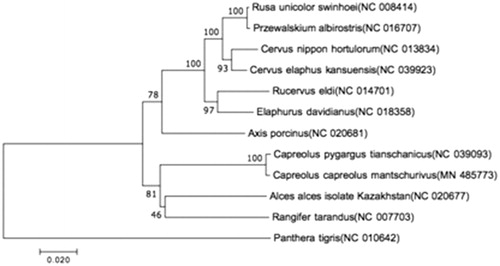Abstract
The roe deer (Capreolus capreolus mantschurivus) is the main prey of the Amur tigers and leopards in the northeast of China. The population genetics of roe deer is closely related to the conservation and management of the endangered species. We first determined and annotated the whole mtDNA genome of the C. capreolus mantschurivus to better understand the evolutionary relationship of these subspecies. The complete mitogenome is 16 355 bp in length, includes 37 protein-coding genes, 22 tRNA genes, 2 rRNA genes, and 1 control region. We built the phylogenetic tree of C. capreolus mantschurivus and other 11 most closely related Cervidae species.
The Eastern roe deer is the most common ungulate in the temperate forest, and the population density of roe deer is an important basis for maintaining a healthy forest ecosystem (Mysterud et al. Citation1999; Morellet et al. Citation2011). The roe deer (Capreolus capreolus mantschurivus) population abundance is closely related to the conservation and management of large and medium-sized carnivores especially in the northeast forest of China (Jiang et al. Citation2015). In particular, Amur leopard, the most endangered feline in the world, has a significant positive correlation with the abundance of roe deer (Qi et al. Citation2015).
In order to save the most endangered big cat in the word, the China government has established the Northeast China Tiger and Leopard National Park in 2017, and Russia established ‘the land of leopard’ national park to protect the habitat of the Amur leopard (Wei Citation2017). However, due to habitat loss and fragmentation and poaching, the roe deer population recovered slowly, which is an important limited factor to population restoration of Amur leopard. The availability of prey resources is one of the main factors affecting the population recovery of large carnivores (Laurenson et al. Citation1995). The NGOs plan to accelerate population recovery of roe deer in potential distribution areas of Amur leopard by means of re-introduction. However, the unclear phylogenetic for endemic subspecies of roe deer should lead to potential genetic pollution.
In order to better understand the genetic and evolutionary relationship between C. capreolus mantschurivus and other sub-species, for the first time, we determined and annotated the complete mitochondrial genome of C. capreolus mantschurivus using 15 pairs of primers. The muscle tissue used for DNA extraction and analysis was sampled from a captived male roe deer in Jiaohe City, Jilin Province, China (N:43.72, E:127.33), and the sample is stored in the zoology specimen of the College of Wildlife and Protected Areas, Northeast Forestry University, Harbin, China. The sample number is NEFU-RD-M-1.
In addition, to reveal the phylogenetic relationship of this species, we reconstructed the complete mitochondrial genome-based neighbor-joining tree of the C. capreolus mantschurivus and other 11 Cervidae species distributed in China with Kimura 2-parameter model using MEGA version 7 (Sudhir et al. Citation2016), and the tree was tested with 1000 bootstrap replications.
The complete mitogenome of C. capreolus mantschurivus is 16,355 bp in length (GenBank accession number MN 485773), which is made up of 37 protein-coding genes, 2 rRNA genes, 22 tRNA genes, and 1 control region. Except for 1 tRNAs, most mitochondrial genes are encoded on the H-strand as in other mammals. The overall base composition is A: 33.5%, T: 30%, C: 23.2%, and G: 13.3%, with a much higher A + T content.
The phylogenetic neighbor-joining tree is shown in and bootstrap supports for most of the tree branches are high. From the neighbor-joining tree, we can find that study can provide the basis for the genetic evolution of deer.
Figure 1. Neighbor-joining phylogenetic tree of C. capreolus and other 11 species of Cervidae constructed by MEGA Version 7.0. Note: COI (Boykin et al. Citation2007) of other 10 species of Cervidae are downloaded from NCBI and the GenBank accession numbers are given in the bracket after the species name.

Disclosure statement
No potential conflict of interest was reported by the author(s).
Additional information
Funding
References
- Boykin LM, Shatters RG, Jr, Rosell RC, McKenzie CL, Bagnall RA, De Barro P, Frohlich DR. 2007. Global relationships of Bemisia tabaci (Hemiptera: Aleyrodidae) revealed using bayesian analysis of mitochondrial COI DNA sequences. Mol Phylogenet Evol. 3:1306–1319.
- Jiang G, Qi J, Wang G, Shi Q, Darman Y, Hebblewhite M, Miquelle DG, Li Z, Zhang X, Gu J, et al. 2015. New hope for the survival of the Amur leopard in China. Sci Rep. 5(1):15475.
- Laurenson MK, Wielebnowski N, Caro TM. 1995. Extrinsic factors and juvenile mortality in cheetahs. Conserv Biol. 9(5):1329–1331.
- Morellet N, Moorter BV, Cargnelutti B, Angibault JM, Lourtet B, Merlet J, Ladet S, Hewison AJM. 2011. Landscape composition influences roe deer habitat selection at both home range and landscape scales. Landscape Ecol. 26(7):999–1010.
- Mysterud A, Larsen PK, Ims RA, Østbye E. 1999. Habitat selection by roe deer and sheep: does habitat ranking reflect resource availability? Can J Zool. 77(5):776–783.
- Qi J, Shi Q, Wang G, Li Z, Sun Q, Hua Y, Jiang G. 2015. Spatial distribution drivers of Amur leopard density in northeast China. Biol Conserv. 191:258–265.
- Sudhir K, Glen S, Koichiro T. 2016. MEGA7: molecular evolutionary genetics analysis version 7.0 for bigger datasets. Mol Biol Evol. 33(7):1870–1874.
- Wei Z. 2017. Official establishment of northeast tiger and leopard National Park Administration. Beijing: China Forestry Industry.
